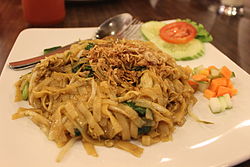Kwetiau goreng
 Kwetiau goreng in a restaurant in Indonesia served withacarpickles and fried shallot sprinkles | |
| Alternative names | Kwetiaw goreng |
|---|---|
| Course | Main course |
| Place of origin | Indonesia[1] |
| Region or state | Nationwide |
| Serving temperature | Hot |
| Main ingredients | Fried flat noodles with chicken, meat, beef, prawn or crab |
Kwetiau goreng(Indonesianfor 'fried flat noodle') is anIndonesian[2]style of stir friedflat rice noodle dish.[1]It is made from noodles, locally known askwetiau,which are stir-fried incooking oilwithgarlic,onionorshallots,beef,chicken,friedprawn,crabor slicedbakso(meatballs), chili,Chinese cabbage,cabbages,tomatoes,egg,and other vegetables with an ample amount ofkecap manis(sweet soy sauce).[2]In Asia,kwetiauis available in two forms, dried and fresh.[3]Its recipe is quite similar to another Chinese Indonesian favourite,mie goreng,with the exception of replacing yellow wheat noodles for flat rice noodles.[3]
Ubiquitous in Indonesia,kwetiauis sold by many food vendors, from traveling street hawkers in their carts (warungs) to high-end restaurants. It is a favourite one-dish meal amongst Indonesians, although street food hawkers commonly sell it together withmie gorengandnasi goreng(fried rice).Kwetiau gorengis also served in Indonesian franchise restaurants.[4]
Indonesiankwetiau gorengusually tastes mildly sweet with a generous addition of sweet soy sauce, spicier with the addition ofsambalchili sauce as condiment, and mostly usinghalalchicken and beef instead ofporkandlardto cater to theMuslimmajority population. The most common protein sources forkwetiau gorengare beef, chicken, prawns, or crab.[2]
Origin
[edit]Chinese influence is evident in Indonesian food, such asbakmi,mie ayam,pangsit,mie gorengandkwetiau goreng.[5]The dish is derived fromChinesestir-friedshahe fenand believed to have been introduced byChinese immigrantsinIndonesiaover several centuries. The Chinese first made contact with Indonesia in the 7th century, and by the 1600s Chinese settlements had sprung up along the coasts of Java and Sumatra.[1]Centuries of interactions between the two cultures resulted in the blending of Chinese and local cuisine.Kwetiau gorengmay be served withsweet soy saucethat adds mild sweetness, or a sprinkle ofbawang gorengfried shallots, orsambalto add spiciness.Kwetiau gorengmay have akrupuktopping to add a crispy texture, and not contain pork or lard to cater for Muslims.
Variations
[edit]
Just likemie goreng,kwetiau gorengrecipes might vary according to its ingredients. The popular variants arekwetiau goreng sapi(beef),[6]kwetiau goreng ayam(chicken),kwetiau gorengseafood (including cuttlefish, prawn and fish) andkwetiau goreng kepiting(crab). Thekwetiau goreng pedas(hot and spicy) uses a lot of chili pepper, whilekwetiau goreng sayuranmainly uses vegetables.[3]
Another popularkwetiaurecipe is calledkwetiau kuah(kwetiauwith soup),kwetiau ayam(chickenkwetiauwith soup) andkwetiau siram(pouredkwetiau), in which the flat rice noodles are boiled or poured with thick soup or sauce instead of being stir-fried. Another variant calledkwetiau bunis similar tokwetiau gorengbut moister and softer with the addition of more water.[7]
There is a variation calledkwetiau goreng lenjer,which is made by slicing thepempekand mixing it with chicken, prawns, eggs, bean sprouts and soy sauce.[8]
See also
[edit]References
[edit]- ^abcAnita (July 11, 2013)."Kwetiau Goreng – Stir Fried Flat Rice Noodles".Daily Cooking Quest. Archived fromthe originalon July 4, 2014.RetrievedSeptember 3,2014.
- ^abcNicole (November 4, 2015)."A Guide on What To Eat in Indonesia Part II".That Food Cray.Archived fromthe originalon October 6, 2019.RetrievedJuly 14,2016.
- ^abcTim Dapur DeMedia (2010).Aneka Masakan Mi, Bihun, & Kwetiau Populer(in Indonesian). DeMedia.ISBN9789791471985.
- ^"Es Teller 77 becomes icon of local franchise business".The Jakarta Post.22 January 2007. Archived fromthe originalon 8 March 2016.Retrieved5 February2016.
- ^Heinz Von Holzen (2014).A New Approach to Indonesian Cooking.Marshall Cavendish International Asia Pte Ltd. p. 15.ISBN9789814634953.Retrieved5 February2016.
- ^Anita (14 July 2013)."Kwetiau Goreng Sapi – Stir Fried Beef and Flat Rice Noodles".Daily Cooking Quest.Archived fromthe originalon 5 February 2016.Retrieved5 February2016.
- ^"Flat Rice Noodles with Gravy (Kwetiau Siram)".
- ^"Bringing local food home".The Jakarta Post.15 November 2009.Retrieved5 February2016.
External links
[edit]- Indonesian Beef Kwetiau Goreng RecipeArchived2016-02-05 at theWayback Machine
